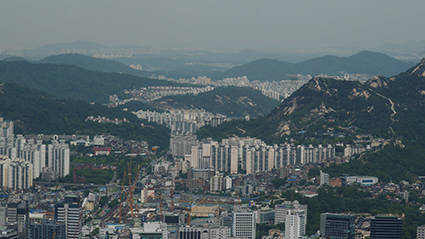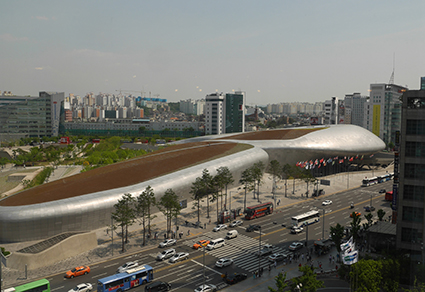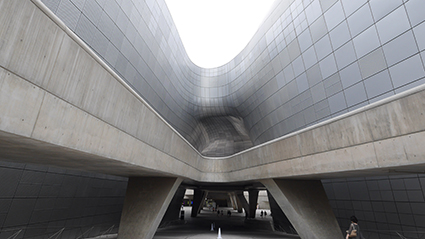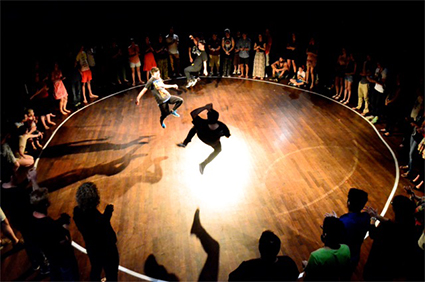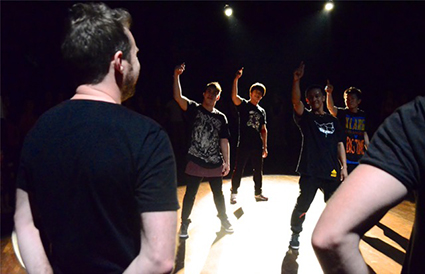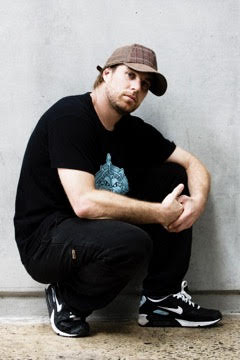July 2015
Reason for travelling
I headed off to Seoul (as well as Tokyo and Osaka) in search of the future, in particular what the future might sound like. This research feeds into a speculative audio and writing project which I am creating as part of my Australia Council Emerging and Experimental Arts Fellowship.
Lit by neon dreams
I was looking for the future in Seoul because, along with Japan and China, the belated acceptance of Western modernity after an extended period of seclusion has resulted in a slam-down-hard on the fast-forward button in terms of technological progress. Seoul is a super clean, efficient and well-planned city, full of ambitious architectural visions, corporate glamour and an obscene amount of retail activity. Amid this unabashed capitalism, you turn a corner and there’s a mountain outcrop—sheer rock faces and luscious greenery—often hiding an opulent and ancient palace (admittedly reconstructed after the devastations of the Korean war).
By day the streets are curiously calm—I kept wondering where the 10 million people who live in the megacity were hiding. But at night everyone hits the streets which are all neon and video screens (some curved and embedded into buildings Blade Runner-style) and the music is turned up loud—each retail shop blaring its own pop-soundtrack. There’s serious touting (each shop has a shouting MC) and the young primp, pose, promenade and of course purchase. The retail orgy continues underground with kilometres of specialist shops branching out from the subways. These often adjoin subterranean bomb shelters—the not so subtle reminder of underlying tensions in the region.
While the mainstream culture of K-Pop, propped up by government investment, is inescapable and the pressures of fashion and beauty industries are a little overwhelming (plastic surgery is a number one seller), Seoul still has a strong art heart, offering a vast amount of cultural activity. While it’s mainly government and corporate sponsored there’s also a dedicated alternative community that keeps things lively.
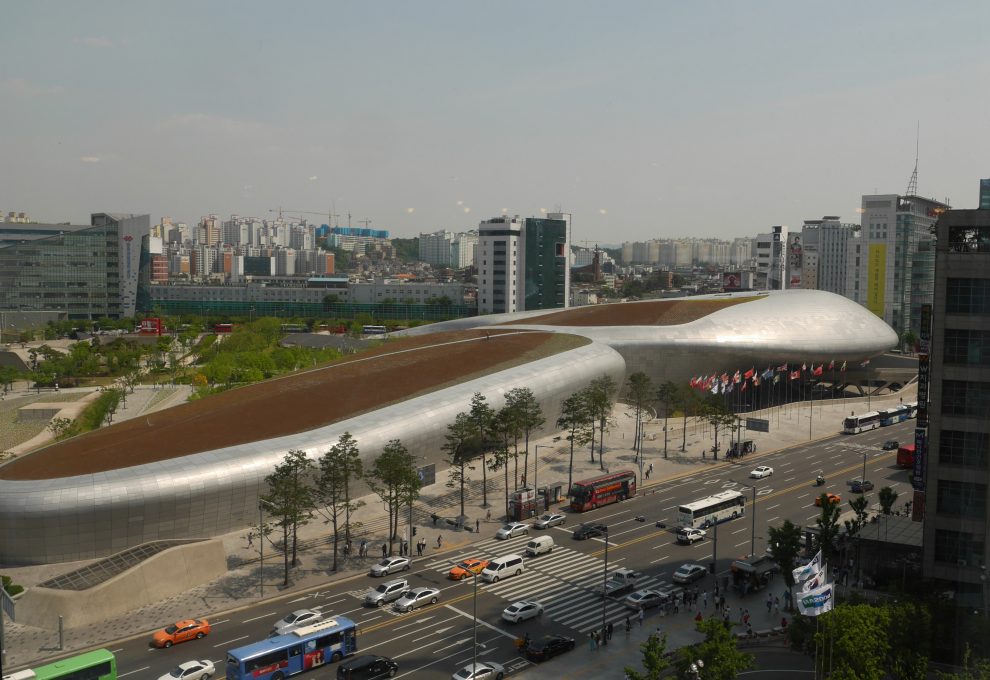
Dongdaemun Design Plaza, photo Gail Priest
Seoul’s big art
Guide books divide Seoul up into to seven key areas all accessible by the wonderfully efficient and cheap subway system. To the north is Jongno-gu which includes the gallery clutch of Insadong—an astounding concentration of small commercial spaces—as well as some of the key larger galleries. (Seoul has so many large art institutions with multiple venues that I was often confused as to which government sponsored gallery I was in).
The National Museum of Modern and Contemporary Art (MMCA) has three venues with the Seoul complex only completed in 2013. When I visited it housed a humorously incisive exhibition by Xijing Men, a group whose work critiques the mechanisms behind contemporary constructions of civilised cities (The World of Xijing, until 9 Aug). There was also a major exhibition, Robot Essay, with a not-so-surprising exploration of humanity’s uneasy relationship with robots (until Aug 30). A pleasant surprise was finding the kinetic sculptures of Australian artist Ross Manning included as part of the Interplay exhibition in which artists have been invited to make works “site-specifically” for the underground gallery spaces. The highlight of Interplay is the otherworldly Liminal Air-Descend by Japanese artist Shinji Ohmaki—a fluorescently lit room full of thousands of suspended white strings through which you walk, a little anxiously entangled in its multi-sensory environment (until 23 Aug).
Just around the corner the Art Sonje Centre was hosting a large installation by Mexican artist Abraham Cruzvillegas. For Autodestrucción8: Sinbeyeong, he gathered detritus from an area in Seoul undergoing rapid renovation to create an intricate spiral maze. His placement of disparate objects and materials end-to-end reconfigures the relationships of items in a fascinating way. Reaching the centre you are rewarded with the sight of an otherworldly white axolotl in a terrarium (until 26 July).
Around another corner is the Kumho Museum of Art, one of the many galleries sponsored by major corporations. Until 23 August it’s showing an excellent exhibition, Into Thin Air, offering sound, video and installation work exploring ‘monotone’ as a state. A particularly impressive work by Kim Sangjin deploys hundreds of small speakers, each issuing a single voice in a beautiful chorus. In another room, behind glass and shrouded in real fog, a life-sized, skeletal tree turns slowly in an endless winter, the work of Rhee Kibong. I stumbled upon Kumho, since there was no web information in English. It was one of the most satisfying exhibitions I attended.
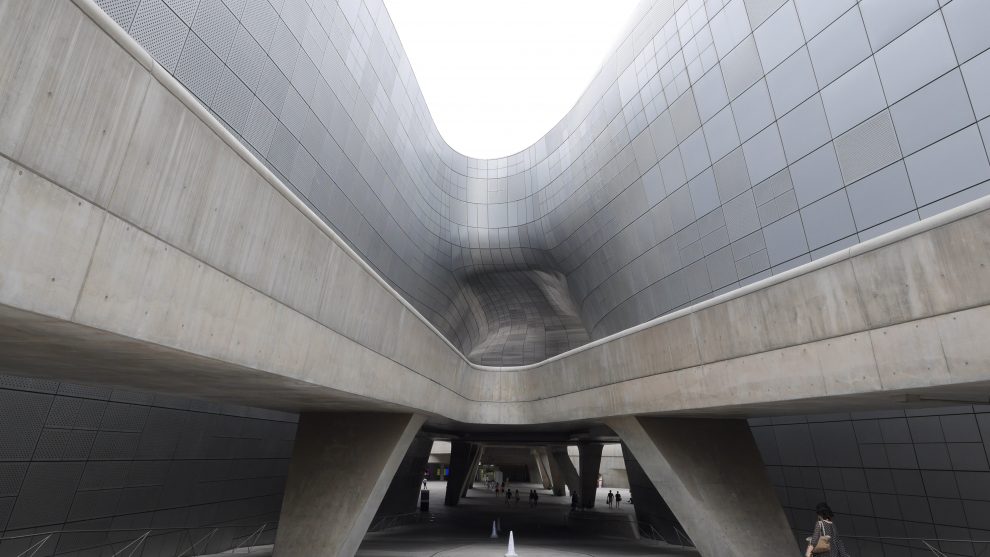
Dongdaemun Design Plaza, photo Gail Priest
I was also inspired by works at the Arko Art Centre, in Daehakno to the northwest. Arko is strongly focused on Korean contemporary art and is also responsible for the INSA Art Space which runs programs for emerging artists. Two great shows were on when I visited: Satin Ions by visiting Swedish artist Nina Canell who has been working with the industrial waste of high voltage electrical cable and playing with the mysteries of electro-magnetic forces (until 9 Aug); and an excellent documentary video and sound project, Time Mechanics, by Korean artist Hwayeon Nam, looking at how objects, ideas and places accumulate cultural resonance.
In the more tourist-drenched area of Iatewon is the luxurious gallery experience that is Leeum, Samsung Museum of Art. Museum 1 houses precious antiquities—porcelain, metalwork and paintings interspersed with a small number of modern minimalist pieces. Museum 2 concentrates on an eclectic collection of contemporary international works by the likes of Rothko, Koons, Judd, Mccarthy, Kiefer and Beuys. And of course, as it seems mandatory these days, there’s an Olafur Eliasson piece which converts a stairway into a sepia Escher etching. Each wing of the gallery has been designed by a different architect—museum 1, Mario Botta, museum 2 Jean Nouvel and the education centre by Rem Koolhaas and the whole complex is guarded by large scale outdoor sculptures by artists such as Louise Bourgeois and Anish Kapoor. (Their website is also excellent, featuring a searchable guide to the collection.) The Samsung Foundation also runs the PLATEAU space in the Jung-gu area. Formerly the Rodin Gallery, its airy atrium holds original bronzes of Rodin’s Gates of Hell and the Burgers of Calais, while the internal gallery spaces feature temporary exhibitions.
Also in Jung-gu is one wing of the Seoul Museum of Art (SeMA) which is responsible for the MediaCity Seoul biennale (last held Nov 2014) with three other venues around the city and including a residency space. Exhibiting an excellent retrospective of the Korean feminist artist Yun Suknam it offered a strong sense of profound and embedded respect for the role of artist as philosopher, critic and visionary within Korean society.
Really, if you blindly stick a pin on a map of Seoul you’re likely to hit a gallery—check the listings guides below for more.
Seoul’s sounds
The inevitable response to the hyperbole of K-Pop, is K-Indie, the ‘underground’ music scene which is now a kind of mainstream in itself. Its home is the Hongdae area (short for Hongik University) in the Mapo-gu district. Full of ‘cool’ young people and heaps of tourists, if you’re looking for live music—rock, reggae, punk, funk, latin—this is the place. (The super-slick gallery Loop Alternative Space is also in the area.) I managed to make contact with a few expatriate Americans who are involved in interesting alternate pop-rock bands—check out Nice Legs and Tierpark if you’re interested.
Looking further underground—for the hard-core experimental—I found a few places, but alas there were no gigs on during my stay. A key space for a kind of non-denominational experimentalism including improv, weird rock, dance and visual art is Expression Gallery Yogiga, run by Hanjoo Lee. For a more concentrated experimental music experience head to dotolim, run by Jin Sangtae. Jin opened his space in 2008 inspired by Ottomo Yoshihide’s GRID605 in Tokyo. The first venue could only fit around 20 people while his current place is just a little bit larger. He runs monthly concerts (up to #74 in the series) featuring local and visiting international artists.
I also managed to chat with other mainstays of the underground noise and electronic scene Hong Chulki and Choi Joonyong who play separately and as the duo Astronoise. Along with Jin Sangtae and a few other key artists, these two have been responsible for most of the experimental sound action in Seoul since the mid-2000s. They run the record label Balloon & Needle and the website is a good resource for what’s going on.

Songdo Future City, photo Gail Priest
Future cities
From an architectural and urban planning perspective, Seoul is racing forward, perhaps not quite at the scale and pace of Dubai and Shanghai, but definitely on its way. One of the newest marvels is the curvaceous “metonymic landscape,” Dongdaemun Design Plaza by architect Zaha Hadid housing galleries, shops and studios. In Seoul’s northwest, near the World Cup Stadium is Digital Media City, a recently constructed precinct designed to attract high-tech companies and home to the Korean Film Archive. It’s an intense collection of steel and glass and shiny public sculptures. At the centre of DMC was to be Seoul Lite Tower, the second tallest building in the world at 640m high, 133 storeys. Construction began in 2009 but was cancelled in 2012 due to budgetary constraints.
Similar overreaching ambition can be seen at Songdo Future City to the south of Seoul near the Incheon Airport. Designed to be an international business hub for North Asia it features multiple housing and business developments on reclaimed land centred on Central Park, a sprawling greenzone and saltwater canal. There are canoes and paddle boats lined up, some deer and even a rabbit island. But currently there’s no one there. One building complex, Tomorrow City, is completely empty and the six-lane motorways are like deserts. It’s weird and wonderfully apocalyptic if you’re into that kind of thing (which I am). Contrast this sparseness with the bustling life of central Seoul’s night markets in Meyondong and Namdaemun and it seems people are still happy to live in a chaotic now, leaving the well-planned future for later.
Thanks to Lauren E Walker, Hong Chulki, Choi Joonyong, Jin Sangtae, Lee Seungjoon and Yoon Jiyoung for taking the time to talk with me.
Links
Museum of Modern and contemporary Art (MMCA)
Art Sonje Centre
Kumho
Leeum Samsung Foundation
PLATEAU
Arko Art Centre
INSA Artspace
Seoul Museum of Art (SeMA)
Expression Gallery Yogiga
Dotolim
Ballon and Needle
Dongdaemun Design Plaza
Digital Media City
Songdo Future City (International Business District)
Gallery guide sites
Art forum Guide Seoul
Art in Asia
The Artro
Art & Seoul
Tristan Meecham
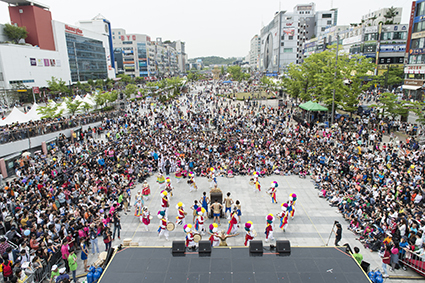
Fun Run
photo Studio Pal
Fun Run
Ansan Street Arts Festival (ASAF) is one of South Korea’s many resplendent arts festivals. Largely dedicated to arts on and of the streets, the vibrant regional city of Ansan blocks off its main streets once a year to fill the epic civic square and precinct with performances and installations from all over the world.
In 2014 Ansan, located on the coast of the Yellow Sea south-west of Seoul, experienced a tragic ferry disaster that saw hundreds of local families lose their beloved children. With the wound still very deep in the national psyche, Ansan Street Arts Festival was cancelled that year.
In 2015, the festival returned with a very clear remit to re-instill joy and pride in the people of Ansan. Over three days in March approximately 100,000 locals flocked to ASAF to experience a gloriously ambitious program featuring many local South Korean performers, European outdoor aerial specialists, pyro-artists and many more. The city was ready to feel the light on its face again.
Australia was represented by Melbourne artists Tristan Meecham and Bec Reid (All The Queens Men) with their endurance spectacle Fun Run and sound artists Madeleine Flynn and Tim Humphrey with the Megaphone Project.
All The Queens Men, FUN RUN
Bec Reid
A one time only event in the middle of the ASAF program, Fun Run directly involved over 700 local community performers in the work itself and was experienced by an audience of over 30,000 people.
This was Fun Run’s first international appearance after presentations at the Next Wave, Darwin and Sydney Festivals. For independent artists it felt a timely opportunity for us to share the work with new audiences and markets and to explore the new artistic and cultural connections we’ve made in South Korea. We’re committed to returning to the land of K-Pop in the near future.
Fun Run is inspired by the story of Phidipeiddes who ran the first marathon in Ancient Greece. For five hours Tristan runs the marathon’s 42.2kms on a treadmill while surrounded and buoyed by local community performances staged every five minutes. The quest for greatness through an immense act of endurance becomes a collective marathon as audiences and community performers alike will Tristan over the line with much confetti.
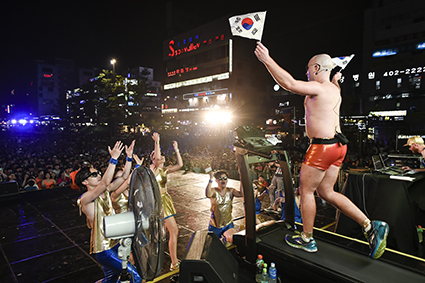
Fun Run
photo Studio Pal
Fun Run
For eight months we collaborated with ASAF seeking out locals with extraordinary physical talents who were primed to be publicly and spectacularly celebrated. The event involved performances by traditional drummers, teenage cheerleaders, junior and senior taekwondo experts, bodybuilders, musical theatre students, aerobics champions, senior line dancers, amateur street dance groups, college K-Pop kids, patriotic belly-dancers, trampolining devotees and sports cyclists. As the protagonist—Tristan as “Humphrey”—ran the marathon, much-loved South Korean actress Younghee Park emceed the event with bilingual aplomb while a troupe of professional dancers became the “Haus Da Humphrey,” performing for an audience of thousands.
It was deeply moving for us to present Fun Run as part of this moment of healing for Ansan. Together the local and visiting international artists and audiences achieved something literally superhuman, artistically transcending the everyday and reminding us that the human spirit endures when we become truly greater than the sum of all of our parts.
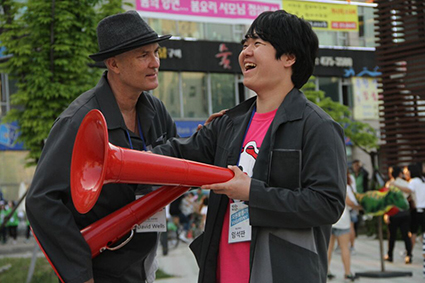
Megaphone Project
photo Jessica Devereux
Megaphone Project
Megaphone Project
Madeleine Flynn and Tim Humphrey
An extraordinary cloud of sound envelops our small Korean and Australian team, its corollary seen in the teeming visual maelstrom of the festival. We are already immersed, visually and aurally, so the installation creates points of focus which guide, then beguile. Thousands of local people, recently struck with tragedy, are ready more than ever to engage with their own sonic identity amid the myriad artworks. Working with local artist Kim Jun-su, we asked about a listening culture, with local answers that fed into the live soundfield, and became a spontaneous live discourse, a wireless multichannel conversation about Ansan.
Our performance at Ansan precedes a new work that we are developing with Kim Joho of Project Jamsang.
From the artists’ website: The Megaphone Project is an interactive sound field, an installation that allows people to discover through sound and physical play a world of private and public broadcast. Twenty-five red megaphones of different shapes and sizes create an interactive performance field for both the public and artists. Over eight years The Megaphone Project has toured Australia, the United States and Finland and been experienced by some 90,000 people.
Ansan Street Arts Festival (ASAF). All The Queens Men, Fun Run, artists Tristan Meecham, Bec Reid, Willoh S Weiland, Nick Roux, Em O Brien, Hyemin Han, Jin-Hyun Yim; Megaphone Project, Australian artists Madeleine Flynn, Tim Humphrey, David Wells, Jessica Devereux, Rosie Carr, South Korean artists Kim Yunjung, Hwan Seok Lim, Kim Jun-su, volunteer Sam Kim; Ansan, South Korea, 5 Jan-5 March
RealTime issue #127 June-July 2015 pg. web
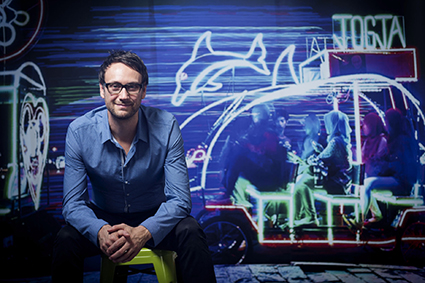
Joseph Mitchell, Artistic Director OzAsia 2015
photo Randy Larcombe
Joseph Mitchell, Artistic Director OzAsia 2015
Adelaide’s OzAsia Festival is soon to burst into new life with a thrilling program of contemporary performance, film and visual art from China, Taiwan, Japan and, above all, Indonesia, in a welcome move that will reveal some of the cultural scale and complexity of that nation.
The festival’s Artistic Director Joseph Mitchell—former Executive Producer at the Brisbane Festival and Senior Director and Producer at Luminato and the Toronto Festival—recalls being surprised, challenged and awed by Asian performance that breaks with tradition while, curiously, sustaining it.
This is the OzAsia Festival many of us have been waiting for, to see work we’ve only ever read about, glimpsed while travelling or, eager to learn, have never heard of, such is the paucity of contemporary Asian performance reaching Australia despite the dedication of a handful of producers. I met with the exuberant and passionate Mitchell in Sydney shortly after the Adelaide launch of his program.
What drove the choices you made?
As the only international arts festival in Australia focused on Asia there’s a great responsibility to ask serious questions about the landscape of contemporary performance across the region and who the artists are breaking new ground. We’re not aligned to any aspect of tradition, like Chinese New Year celebrations; OzAsia is an arts festival in which we get a better sense of contemporary Asia. The festival brief is enormous; we’re talking about two-thirds of the world’s population.
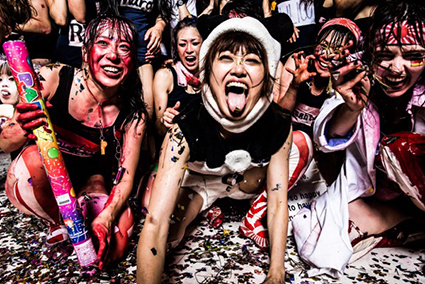
Miss Revolutionary Idol Berserker, OzAsia
photo courtesy Adelaide Festival Centre
Miss Revolutionary Idol Berserker, OzAsia
What does Japan’s Miss Revolutionary Idol Berserker exemplify about your program?
They’re a group of 30 young artists living around Shinjuku in Tokyo. They’re not interested in traditional performance or text-based performance or replicating performing art practices from the West They’re exploring the boundaries of art on their own terms, which is what OzAsia is about.
What’s their medium?
It’s a complete amalgam of audience immersion, multimedia projection, theatricality and fast-pace choreographed movement. But if you said it was dance or theatre to a dance or theatre person they’d get upset. It’s not like anything you’ve seen before. They have a cult following in Japan and play in dingey 100-150 seat venues. I’ve seen them twice in Japan with audiences that might include a 50-year old businessman curious enough to go on his own or young uni students who’ve heard about a show where anything can happen.
They perform with such self-confidence that you take the show on as it is. You have to take your shoes off, wear a raincoat and you get pummelled with seaweed and tofu—the stereotypes of Japanese culture thrown in your face. They dance precisely with fluoro lights but at the same time it’s chaotic, with a lot of video projection and spoken word harking back to the young Japanese of the 1970s dissociating themselves from the culture of American occupation as well as from Japanese tradition and finding their own sense of identity. You can read all that in the work or just enter the madness for 45 minutes and say Wow!
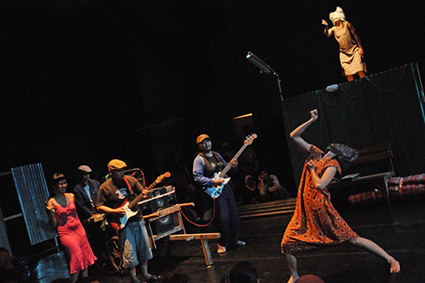
Teater Garasi, The Streets, OzAsia
photo courtesy Adelaide Festival Centre
Teater Garasi, The Streets, OzAsia
Indonesia features strongly in your program. Who are Teater Garasi?
Teater Garasi have been performing for 20 years, starting out as university students in Jogjakarta and hitting their stride in the post-New Order, post-1998 era when Indonesia found its feet as a democracy. They’ve built a body of work in the first decade of this century, not from text or improvisation or dance, but fusing styles in a process of their own involving history and politics and issues of wealth and poverty, the rural and the urban and asking ‘are we ready to be a democracy?’ They’ve toured through Asia and into Europe. The Streets is one of their most accessible works, others are dense and too culturally specific except perhaps for audiences in Singapore and Japan. Again, like Miss Revolutionary their work is immersive, someone will give you beer or beg or ask you for identification.
The Streets is dance theatre interspersed with monologues and statements about Indonesian culture now. Where else in the world does on an angle grinder cutting corrugated iron cut across a monologue in a dance theatre work? It’s what Jakarta is like.
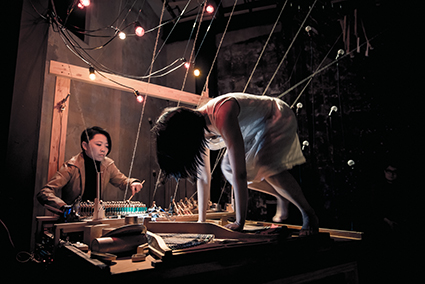
Dear John
photo courtesy of Adelaide Festival Centre
Dear John
Move Theatre’s John Cage appears to be an unusual choice.
Move Theatre’s Dear John features a dancer, a composer, a bowed piano player and installation and sound artists from Taiwan who’ve set up a black studio space with an installation of components that can be played by the artists and the audience. As a tribute to John Cage the work makes the audience hyper-aware of the sounds in the space around it. It’s not recreating or mimicking a Cage work but asks how he inspires us to play at the boundaries of music and contemporary performance-making in an immersive environment—it’s a living work of art that needs an audience that feels permitted to make it. It’s also a stunning, empowering work that comes from research, collaborating and thinking outside of the box.
You have included some explicitly traditional performance in your program.
The Indonesian Topang mask dance from the Cirebon province on the northern tip of Java has rarely been seen in Australia. It’s traditional dance but absolutely hypnotic and you can see how influential it’s been on contemporary performance makers with its commitment to dropping into character, letting go of the self, gesturing to the gods. For another of their works Theatre Gerassi went and studied the practice; it’s not evident in the final product but it is there. The 600-year old choreography is stunning and still relevant.
Performance art has a special place in the festival as well as contemporary theatre. Does it connect with traditional performance?
The Indonesian artist Melati Suryodamo trained with Marina Abramovic, absorbed postmodern culture in visual and performance art and now, as a mature artist, she’s connecting with her Javanese roots with depth and rigour. She’s a world leader in performance art, but with a sense of it as 800 years old—the tradition that includes shamanism, the loss of control of the body and then the body itself as art.
We’re building a special performance space next to the Festival Centre Gallery for Melati’s two-day durational performance, 24,901 Miles, on OzAsia’s opening weekend. It’s her first Australian commission and I wanted it to be a new work, not a restaging. For me a performance art work is only valid as one performance. We’re mounting a retrospective of her performances and her video work for the three weeks before she performs.
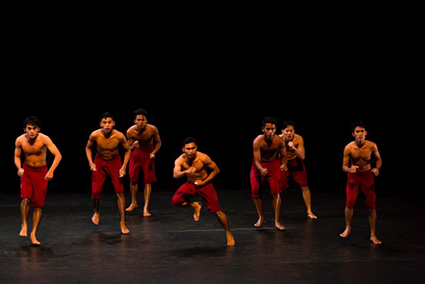
Cry Jalilolo
photo courtesy Adelaide Festival Centre
Cry Jalilolo
I saw work by Eko Supriyanto’s in Jakarta in 2010 and was impressed by its vibrant patterning and its deep connections with traditional dance while still looking very modern. His audience loved him with passion.
Eko’s Cry Jalilolo is probably my pick of the festival. He’s working with a group of young men, not professional dancers in a Western sense, who come from a village in Jailolo Bay in north Maluku (the Moluccas, east of Borneo), The regent of that area invited Eko to create a dance work as part of their summer festival. It’s a village with its whole culture built around fishing and coconuts. Eko watched the boys perform their island’s traditional dance, learned who they were, what their passions in life were and their concerns—destruction of their reef, dynamite fishing, rubbish and pollution in the ocean. He reconfigured the movement into contemporary dance in a perfect fusion and with respect for tradition. Tradition and the contemporary aren’t as separate as we sometimes think and artists like Eko are held in great respect. These young men are touring the work for the next two years.
Eko wanted to give something back to the community. I went to Jailolo with him where he taught the whole work to 200 children over two months and then they and the seven dancers performed the work to the whole population of the island.
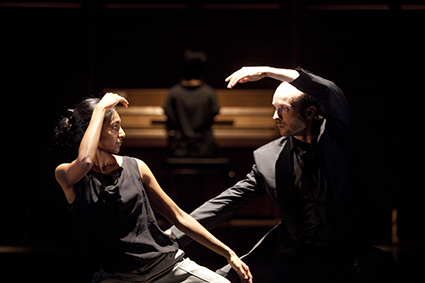
Play
photo courtesy Adelaide Festival Centre
Play
There’s much cross-artform collaboration at work within the groups you’ve invited but it’s also evident in combinations across cultures: Sidi Larbi Cherkaoui and Indian Kuchipudi dancer Shantala Shivalingapp in Play, and Kyle Page, Dancenorth and a Japanese Butoh collective, Batik, in Spectra.
It’s easier now for international collaborations than it was 10-15 years ago. The key things are mutual respect between the artists, curiosity and a desire to discover something new, which happens when boundaries disappear. There have been so many successes for choreographers internationally in the last decade coming out of these collaborations.
Play, which is dedicated to Pina Bausch, came out of her pairing the artists, the non-stop curious dancer and choreographer Sidi Larbi Cherkaoui and Indian Kuchipudi dancer Shantala Shivalingapp. He reflects on his life, she on hers in Paris and they’ve never stopped working on Play over many years. I’ve seen it twice in the last three years and there was 30% new content the second time. What I love is that it is not sleek modern dance, which I don’t dislike, but that it takes time, that the audience and dancers are in this together—the dancers watch each other, listen to the audience and tweak the work without the sense of a fourth wall.
Kyle Page, the new Artistic Executive of Townsville’s Dancenorth and a former Dancenorth and ADT dancer, is also very curious and an amazing listener, always wanting to discover something and sees Asia as the place for that. He pursued this project, Spectra, himself in Japan, finding Batik, a female collective Butoh group, a leading digital artist Tatsuo Miyajima and composer Jiro Matsumoto to work with Dancenorth.
From China you’ve chosen a significant theatrical production; is this another boundary breaker?
Amber [premiered Hong Kong, 2005] is a conventional play—but with singing, dancing and projections—from probably the leading Chinese theatre director, Meng Jinghu [director of the National Theater of China]. He doesn’t direct Western plays. His wife Liao Yimei is the playwright. He’s prolific, making fun, fluent shows about young people on his own terms. Rhinoceros in Love is still in repertoire [OzAsia 2011] since 1999. His shows touch a nerve about contemporary culture and are packed with under–40 audiences. There’s an inherent through-line of absurdity in his work, but with more of a narrative thread in Amber than Rhinoceros, [In Amber the heart of a man who is killed in an accident is transplanted into the body of a decadent character. The dead man’s girlfriend believes she can redeem the rogue redeem his soul. Eds]. It’s a love story, if not a straight narrative—he makes the audience work. It’s about finding your own path in the new China: is sex for fun or love, with whom can you have it, is it taboo?
The film program will introduce audiences to Hong Kong filmmaker Ann Hui—doubtless a new name to many.
Ann Hui has a 40-year career of making exquisite films about the family in the greater Chinese region. Glenys Rowe of Adelaide’s Media Resource Centre finalised the selection of six films for me. Ann Hui’s a woman in the male-dominated, action-film Hong Kong film culture—again OzAsia shifts our perspective.
Of a number of visual arts show, Alhamdulillah, We Made It appears to me the most intriguing.
We commissioned this from Indonesia’s Mess56, 20 people who have a studio in Yogjakarta and sometimes band together to do projects as a collective. They’ve turned the immigration issue on its head. Refugee detention camps are off the radar for most Indonesians. The idea was to get some sense of the people in this purgatory, why they’re there and where they think they’re going. The artists conducted it like a documentary research project with interviews and taking photographs. Then they digitally ‘migrated’ the people by superimposing images of them onto where they’d like to be, say in Australia.
It’s a fine artistic line they’re walking but it’s not about the base level Asian-Indonesian debate over refugees but a fundamental questioning about detention camps in their country and the feelings of the refugees.
With its boundary breakers, cross-artform and cross-cultural collaborators and inventive inheritors of tradition what does this OzAsia Festival add up to do you think?
A festival of strong contemporary art, not a festival of otherness. At the same time it will show Australians how young artists in Asia see themselves, their culture and their art.
See RealTime 128 for interviews with Teater Garasi and Kyle Page of Dancenorth.
Adelaide Festival Centre, OzAsia Festival, Adelaide, 24 Sept-4 Oct
RealTime issue #128 Aug-Sept 2015 pg. web
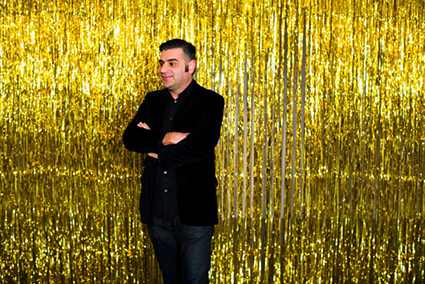
Michael Dagostino
photo courtesy Campbelltown Arts Centre
Michael Dagostino
Interactivity and immersion, live and digital, are the go-to states of the moment. The staging of Carriageworks’ 24 Frames Per Second is spatially immersive, with paths to, between and into recorded film/video works jointly made by visual artists and choreographers. In Sue Healey’s On View at Performance Space (also at Carriageworks) the sensory embrace is felt in the interplay between live dancer-choreographers and Healey’s film images of them.
In Campbelltown Arts Centre’s I Can Hear Dancing immersion is realised not simply in the live pairing of choreographer and composers/sound artists, but also in the spatial constructs they’ve designed for audience engagement, as CAC CEO Michael Dagostino explained to me shortly before the first work of the season is to premiere.
This program has been three-years in the making. Describe its evolution.
Our former Dance Curator Emma Saunders and I were looking beyond what was happening in contemporary dance and we thought there was a really interesting synergy between contemporary dance and music. We came to the conclusion that I Can Hear Dancing could be a model for joining contemporary musicians with choreographers in a way that removed the usual hierarchy, to create an equal platform. So we came up with a list of artists and started pairing them up. At Campbelltown, we see ourselves located on the edge: we’re on the edge of Sydney, the edge of Western Sydney and also on the edge of contemporary art production. And we’re always trying to encourage new ways of working. For example, one pair is Anthony and Julian Hamilton. Antony is a well-established choreographer and his brother Julian is one of The Presets duo. They hadn’t worked together previously so we thought that was a pretty interesting idea.
Who’s managing the program?
Kiri Morcombe, a really interesting curator who has worked at the Australia Council, FORM Dance Projects and Blacktown Arts Centre, has done a lot of work to put this program together after Emma Saunders set it off and then moved on to other things.
I gather there’s an installation element to the program.
All three works involve construction. I guess “sets” is not the right word but definitely installations which the audience will journey through. In the Hamiltons’ Ruth the audience will be led through a number of ‘sites’ within the theatre.
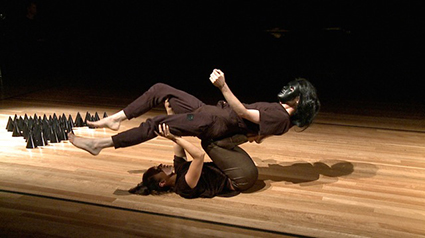
Ruth by Antony & Julian Hamilton
photo courtesy Campbelltown Arts Centre
Ruth by Antony & Julian Hamilton
Watching Antony Hamilton’s creations [Keep Everything, Black Projects 1 & 2] is always very immersive with his intense play with light and dark and figures integrated into the design—or making it as they perform. Will he be dancing?
Not this time. There are two dancers and the audience is a major part of the work—not participating as such but forming a part of the structure. I can’t reveal too much more. Julian will also be performing. He’s a classically trained pianist and he’s moving back towards that in his new composition for Ruth.
What’s the kinship between Kate Mcintosh and the Sydney percussionist Bree Van Reyk in their work, In Stereo?
Kate’s a Berlin-based, New Zealand born choreographer and performance, video and installation artist who works predominantly with space. So the abstract nature of her work creates a natural synergy with Bree’s. They have non-narrative based practices. With Bree it’s percussion with elements of minimalism, as there is in Kate’s. We thought there might be a natural collision between the two and they’ve been working effectively together with Kate dancing and Bree playing.
All these works are still in development. We’re not going to know the final outcome for a while. We’re getting closer as we speak with Antony and Julian’s work while Kate and Bree and Julie-Anne Long and Glen Thompson are in the final stages.
The Long-Thompson work is intriguingly titled 4’33” Into The Past, an obvious reference to the historical John Cage moment.
They’re both very lateral and also deal extensively with popular culture. I’m fascinated to see how they deal with John Cage’s silence. The site they’ve chosen is the gallery space, with an exhibition in it—which can feel very immersive. They’ve also asked for the space not to be empty [of gallery-goers] as well. At that time we’ll have the Imperial Slacks show—Cosmic Love Wonder Lust, a survey of works from Sydney’s Imperial Slacks venue [see RT 128]—so that’s going to be a very interesting juxtaposition.
There’s also an accompanying film by Deborah Brown and Lucy Phelan.
Deb Brown is a dancer, not so much a choreographer. She’s currently in Bangarra’s Lore at the Opera House. Lucy Phelan is a musician and sound artist. They’ve been paired up to talk, through film, about Indigenous identity politics and what it means to be Indigenous in contemporary society. It’s a beautiful film and features our local Indigenous dance group.
Tell me about this group.
It was set up about two years ago when a group of Aboriginal women wanted to connect back to culture through dance. So we set up an Aboriginal women’s dance group and it’s been through a couple of iterations. Now we’re focusing on young women. Some of the older women as well as younger women performed in Deb’s work and they constructed parts of the narrative. Sharni Potts, a significant young local choreographer, also appears in that work. She studied at NAISDA and manages the dance group.
What length is the film?
About 11 minutes. There’ll be a community premiere quite soon and it’ll be screening at all the performances. Deb led the project with a professional film crew shooting onsite in the theatre and in various locations around Campbelltown.
I Can Hear Dancing seems like it will provide and interesting counterpoint to 24 Frames Per Second.
All of these works are still very much about the live event.
I Can Hear Dancing, Anthony Hamilton, Julian Hamilton, Ruth, 7pm. 8.30 pm, 24, 25 July; Kate McIntosh, Bree Van Reyk, In Stereo, 7pm, 28, 29 Aug; 4’33’ into the past, Julie-Anne Long, Glen Thompson, 25, 26 Sept, 7pm; Campbelltown Arts Centre, NSW
RealTime issue #127 June-July 2015 pg. web


